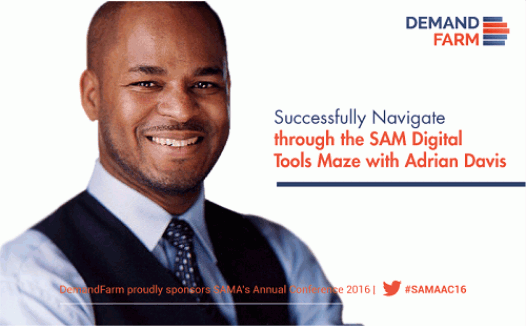Shift to Digital Key Account Management with Anees Merchant

As Key Account Management practices head towards a virtual direction, technology takes the center stage. Account Managers and Sales Leaders have to accommodate evolving customer trends and expectations. DemandFarm’s Dr. Karthik Nagendra – Chief Marketing Officer had a one-on-one conversation with Anees Merchant – EVP Global Growth, from Course5i on the Digital Key Account Management journey. Course 5i is a pure-play data analytics and insights company that focuses on helping organizations drive digital transformation using artificial intelligence (AI), advanced analytics, and insights. The following sections cover some of the inputs from the discussion with Anees Merchant about technology as a key enabler, leveraging multiple stakeholders, transitioning into a digital era of Account Management and much more. Digital Key Account Management – why is it needed now? The optimum process to drive sales and client organization involves account management principles and practices. It is important to not only have a large set of accounts within an organization, but also to have good value accounts. When delving deeper into key accounts, understanding their innate capabilities is needed. Account management institutes a process and governance within the organization not only with the sales or client-facing teams, but also with the entire organization. This sort of Key Account Management process helped scale up Key Accounts. Digital Key Account Management in particular has transformed interactions with clients and how to build relationships at a larger scale. In addition, the digital Key Account Management space is also one that is continually evolving. According to Mr. Merchant, “Buyers have changed their behaviors in a significant way. There are many people now who can participate in the buying decision which was never the case before.” Day by day, it is becoming vital for organizations to leverage technology to enable key account management processes. Challenges when adopting Digital Key Account Management “We also had our own share of learning challenges along the way. At the end of the day we work with humans and we work with human behaviors and it’s hard to change,” says Mr. Merchant. Here are a few challenges that were encountered when shifting to Digital Key Account Management within Course5i. Building processes of governance and reporting so that employees feel that Key Account Management is a part of their job, and not just an additional burden. Integrating finance organizations within this process. Inculcating a sense of transparency into the process so that visibility into industry benchmark and company benchmark fosters growth. Making the Key Account Management process more real-time as an analytics and AI company. Benefits of adopting Digital Key Account Management The following are some of the benefits that have come from shifting to a Digital Key Account Management process. 1. Marquee Accounts Every organization has certain marquee accounts, long tails and recently acquired accounts within key industries. After adopting digital Key Account Management practices, sales leads are able to identify patterns between these accounts and between different verticals that can be leveraged. Marquee accounts are getting bigger and long tails are driving better growth for the company as well. 2. Enhanced customer centricity Integrating digital tools into the Key Account Management process of an organization has the ability to enhance understanding of the customer for the sales team. The ability to look at an account from various facets and various departments in an organization gives a real insight. Shifting to Digital Key Account Management enables scaling up accounts in this manner. Things to keep in mind when adopting a Digital Key Account Management process 1. Get the process right: Think before you act on how to go about before you bring on the technology element. It is crucial to understand, plan and map out how you will be able to go ahead and drive revenue goals. 2. Transparency: Involve people within the organization as part of the process from the beginning itself. This helps unburden the process of transition. Additionally, they can see the impact a digital Key Account Management system would make and how it can improve the overall functioning of the organization. 3. Integration: It becomes much more difficult to drive a piece of technology if it does not seamlessly integrate within the existing ecosystem. The transition to adopting a Digital Key Account Management becomes much easier when it can gel with your existing CRM platform. 4. Do a pilot: Depending on the size of your organization, doing a trial of the Key Account Management processes with a few accounts can bring a deeper understanding when it comes to the hindrances and value that you are able to incorporate. It is critical to keep all these aspects in mind when evaluating the different platforms for transitioning into digital Key Account Management. This is what makes DemandFarm’s Org Chart and Account Planner stand out. They integrate without any hitches to your CRM platform. Listen to the complete conversation with Anees Merchant below.
What DemandFarm brings to the table! (Milind Katti at the SaasHoles Podcast)

Milind Katti at the SaasHoles Podcast Key Account Management is rapidly changing from traditional methods to becoming digitized. Watch Milind Katti, COO & co-founder at DemandFarm, in conversation with Kevin Gaither and Pete Jansons in the SaasHoles podcast. Find out how DemandFarm came to be pioneers in Digital Account Planning. Track the shift from individual-driven to data-driven account planning. Get to know the benefits of converting tacit knowledge to enterprise memory. Check out the following topics in this podcast: Relationship Mapping & Account Management Building relationships as account managers The role of automation in SaaS Hunters vs Farmers in business
Interview with Olivier Riviere – Consultant & Head of the KAM Practice at Invalio

Olivier tell us about your journey as a Key Account Management Professional and how do you help companies achieve growth through focusing on their strategic partnership with the key account? In the course of my career, from junior team member to Executive in charge of Key Clients, I have always been involved in the relationship with truly strategic customers across various industries: design and manufacturing, semiconductors, Entreprise Software and B2B Marketing & Communication Services. In addition, and I am grateful for this, my job also always included driving a true co-creation process with strategic customers and initiatives aiming at influencing the whole business ecosystem. When I became a consultant, I have quite naturally put these topics at the core of my activities. With my partners, we help companies of all size, analyze their strategic context, customer portfolio, and organizational dynamic in order to design and implement a KAM/GAM approach in line with their strategy, resources, and culture. I insist on working simultaneously on the KAM system AND the people involved in KAM; their skills, their motivation and how they collaborate and with their Customers. When is the right time for businesses to start looking at their client relationships in the more strategic manner? There are many reasons why companies should run a sharp analysis of the true value of each Customer and drive the engagement with selected Accounts more strategically. In theory, you can start at any time and the sooner, the better. As an example, start-ups operating in a B2B environment could take advantage of using KAM techniques upfront, although very few do it. In reality, for medium-size and large companies, the trigger situation for KAM comes from a combination of internal and external factors. The major internal factor is when the Executive Team realizes that KAM is a powerful instrument to accelerate the execution of the company’s strategy, whatever its specifics. The external factors are related to an evolution of the environment: market concentration, competitive threat, new regulation, or the need for more innovation. The trigger situation can also simply be the request of a few Customers to receive special treatment. All in all, it is the job of the Executive Team to assess when to start KAM, and it is an area where some external help can bring very high value. What are the biggest obstacles you see businesses face toward becoming more oriented toward servicing & acquiring a deeper understanding of their strategic accounts? The biggest obstacle is definitely the culture. Exploring the true value of each customer and categorising them accordingly, developing a deep sense of the real Customer Experience and where it matters to improve it, further developing the network of personal relationships with Key customers, all of this requires teamwork, collaboration, and the capacity to drive a sustained collective effort that cuts across disciplines and organisational boundaries. Most companies and not only large ones have difficulties to do this. When you look at why KAM initiatives fail to deliver on their promise, the lack of attention paid to cultural change is always part of the picture. Another frequent challenge is the lack of depth of the analysis of the Key Account organization and the network of relationship. The superficiality of the analysis prevents the vendor’s team from finding new angles to strengthen the ties with strategic customers. Software is eating the world & account management could not escape! Do you feel there is a need of having specialized platforms or software for strategic account management? The answer is definitely yes. CRM systems are currently not adapted for true KAM.and other tools are required. This being said there are different sort of needs that can be covered with an adequate software application. Account Planning and monitoring of execution Definition and management of the Value Proposition Opportunities & Share of Business Management Relationship & Influence Management Communication and Operations (team portal and customer portal) These 5 themes are quite differentiated although they do overlap. I am not sure that a single platform will be able to cover all these needs at the same level of depth and for all type of companies in the near future, but I do not see this as a big problem. Companies need to assess their needs and explore where they should consider adding one or several KAM specific tools to their existing software stack (or replacing old applications by new ones). Will such tech platforms become ‘a must have’ for account managers and their leadership or do you feel it constitutes ‘a nice to have’ capability? We are in a transition era. Commercially available Software tools for KAM are just emerging. I strongly believe that the trend will accelerate rapidly and that the benefits of such platforms will be increasingly recognized by more and more KAM and IT professionals. As the awareness of such tools, and probably the breadth of the offering, improve, KAM practitioners will have to avoid to reproduce the same deadly mistake as in CRM: namely putting the tool before the people. KAM software tools will bring value only if the KAM methodology and toolset used by a company are adequate and if the KAM teams – all people involved in KAM – are sufficiently skilled. Such needs are not covered by any piece of software but by Skills development through training, on-the-job coaching, and experience sharing and by a true focus on teamwork. What is your one mantra for growing strategic client relationships? Act like an entrepreneur. Be able to think and help others think out of the box and secure support for these new ideas. In addition, don’t be rebuffed by resistance and demonstrate patience. Would you like to share an interesting business book you have recently read and what was the key takeaway for you? I recommend “Give and Take, Why Helping Others drives our Success by Adam Grant”. One of my customer, Head of KAM in a German industrial company, has used this book to open the eyes of his colleagues
Demand Farming – Co-creating Customer Value

Many organizations are late in waking up to the value of a Strategic Account Management program. If you were to look at trends in the lead to deal funnel, Account Managers are predominantly talking about how data is not easily accessible or is not leveraged fully or effectively, there is a sustainability challenge in the process and therefore the results; how a formal Key Account Management process will boost results and how a software platform derived from best practices of KAM will help them. Reproducing here, some trends from DemandFarm Inc.’s report on ‘The Hype & Art of KAM’. Industry reports state that about 60% of organizations lose deals because competitors establish a better relationship with the customer. 50% of companies use the attribute “strategic fit” to select their key accounts, followed by 27% using “past/current revenue” for key/strategic account selection. 8 % of respondents identified access to customer executives and decision-makers as the main KAM challenge. 60% of respondents from best-in-class enterprises feel that their biggest KAM challenge is the balancing of short-term sales goals with long-term CRM goals. 2% of organizations still do not have a formal key account management process. 50% of respondents say data about key accounts in their organization is fragmented and not easily accessible. 83% of respondents believe that KAM planning and strategizing will receive a huge boost, with the adoption of a KAM software platform. 60% of respondents feel a software platform derived from KAM best practices would be useful to them. 28% of respondents feel a built-in account planning process would significantly aid them in planning and optimizing revenue from key accounts. To address these challenges, it is important to learn about the different stages of the enterprise lifecycle, how clients and providers view their relationships, what a good client relationship is about as well as how it can impact your results. While doing this, it is integral to adopt one of the two processes – transactional or transformational. Sitting on the fence between the two could prove to be a hindrance in creating and maintaining a happy account. The presenter, Adrian Davis, President, Whetstone Inc. also takes you through the above, as well as Winner’s Quadrant, the Knowledge Funnel, and other important things. He also helps you discover and discuss effective features of SAM software such as Account Whitespace Analysis, Organization Chart with Heat Map Analysis that could tilt the scales in your favor. The session happens now at SAMA’s Annual Conference 2016. Here’s to customer value! To learn more, join the session by Adrian Davis at #SAMAAC16‘.
 On-Demand Webinar: Unfiltered take on AI in Account Planning: Meet DemandFarm’s KAM AI
On-Demand Webinar: Unfiltered take on AI in Account Planning: Meet DemandFarm’s KAM AI 

